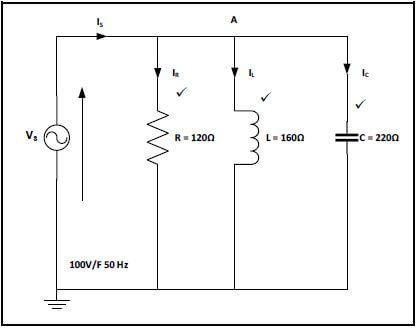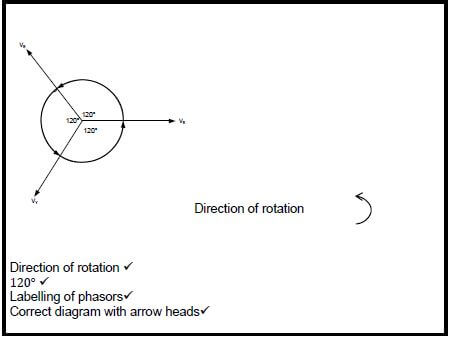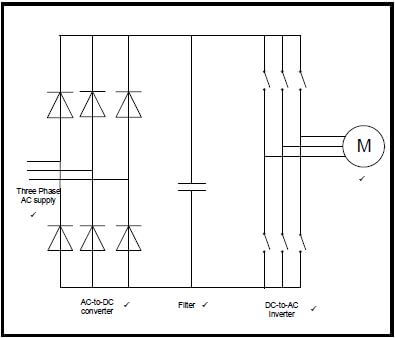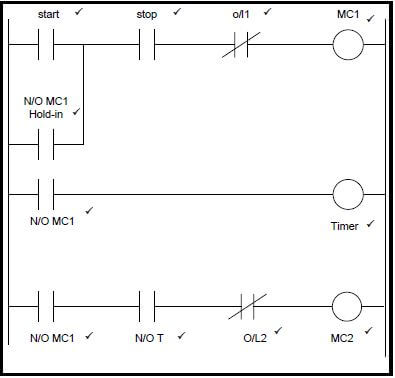Electrical Technology: Power Systems Grade 12 Memorandum - NSC Exams Past Papers and Memos September 2019 Preparatory Examinations
Share via Whatsapp Join our WhatsApp Group Join our Telegram GroupINSTRUCTIONS TO MARKERS
- All questions with multiple answers imply that any relevant, acceptable answer should be considered.
- Calculations:
2.1 All calculations must show the formulae.
2.2 Substitution of values must be done correctly.
2.3 All answers MUST contain the correct unit to be considered.
2.4 Alternative methods must be considered, provided that the correct answer is obtained.
2.5 Where an incorrect answer could be carried over to the next step, the first answer will be deemed incorrect. However, should the incorrect answer be carried over correctly, the marker has to re-calculate the values, using the incorrect answer from the first calculation. If correctly used, the candidate should receive the full marks for subsequent calculations.
2.6 Markers should consider that candidates' answers may deviate slightly from the marking guideline depending on how and where in the calculation rounding off was used. - These marking guidelines are only a guide with model answers.
- Alternative interpretations must be considered and marked on merit. However, this principle should be applied consistently throughout the marking session at ALL marking centres.
MEMORANDUM
QUESTION 1: OCCUPATIONAL HEALTH AND SAFETY (GENERIC)
1.1
- Faulty tools or equipment ✔
- Poor ventilation ✔
- Poor quality or missing guards on machines. ✔
- Excessive noise
- Lack of knowledge of emergency procedures
(Any THREE relevant answers) (3)
1.2 The purpose of the Occupational Health and Safety Act is to provide for the health and safety of:
- Persons at work ✔
- Persons in connection with the use of plant and machinery ✔
- The protection of persons against hazards arising out of the activities of other persons at work
- To establish an advisory council for occupational health and safety and related matters (2)
1.3
- Horseplay ✔
- Running in the workshop ✔
- Throwing things
- Leaving bags, stools or material in walkway
- Spilling a liquid or oil without cleaning
- (Any relevant answer) (2)
1.4
- Keep person lying down ✔
- Cover the person to maintain body heat ✔
- Do not move the person in case of neck or spine injuries ✔
- If unconscious, put them on their side (recovery position)
(Any THREE relevant answers) (3) [10]
QUESTION 2: RLC CIRCUITS (GENERIC)
2.1 Q-factor for a parallel circuit concerns the relationship between the resistance and the reactance of the circuit. ✔ The Q-factor of the circuit is found from the ratio between the reactive components, either the inductive or capacitance at resonance, and the active power of the resistance. ✔ (2)
2.2 Factors that affect the impedance of an RLC circuit:
- Frequency ✔
- Inductance ✔
- Capacitance ✔ (3)
2.3
- Z = R ✔
- XL = XC ✔
- Cos θ = 1 ✔
- R = minimum
- I = maximum (Any THREE) (3)
2.4
2.4.1 (3)
(3)
2.4.2  (3)
(3)
2.4.3 lagging ✔ (1)
2.4.4 The Q-factor will be halved ✔because the Q-factor is inversely proportional to the resistance of the circuit. ✔ The doubling of the inductance and capacitance as a ratio will have no effect on the Q-factor. ✔ (3)
2.5
2.5.1 (3)
(3)
2.5.2
I = V
R
= 100
120
= 0,83A (3)
2.5.3
I = V
R
=100
120
= 0,83A (3)
2.5.4
IC = V
XC
=100
220
= 0,455 A (3)
2.5.5  (3)
(3)
2.5.6 (3)
(3)
2.5.7 (4)
(4)
[40]
QUESTION 3: THREE-PHASE AC GENERATION (SPECIFIC)
3.1 The switchgear is used to interrupt or reconnect ✔ very high voltages and very high amounts of power ✔ (2)
3.2 (4)
(4)
3.3
3.3.1
- PT = W1 + W2
W2 = PT - W1
= 4 000 − 2 500 ✔
= 6 500 W or 6,5 kW ✔ (3)
3.3.2 To eliminate the need for precise mechanical components ✔and to reduce the need for calibration and adjustment ✔ (2)
3.4
- Installation costs are very high ✔
- Not available everywhere ✔
- Not suitable for residential areas
- Appliances are expensive (Any TWO) (2)
3.5.
- Static capacitors ✔
- Synchronous motors ✔
- Phase advancers ✔ (3)
3.6
3.6.1
- VPH = VL
= 250 V✔ (2)
3.6.2
- S = √3VLIL
IL = S
√3VL
= 300 000
√3 × 250
= 692,82 (3)
3.6.3
- P= √3VLIL cos θ ✔ P = S cos θ ✔
= √3 × 250 × 692,82 × 0,866 ✔ = 300 000 × 0,866 ✔
= 259 799,88 W OR = 259 800 W
= 259,8 kW ✔ = 259,8 kW✔ (3)
3.6.4
- θ = cos−1 0,866 = 30° ✔ θ = cos−1 0,866 = 30° ✔
Q = √3VLIL sin θ ✔ Q = S sin θ ✔
= √3 × 250 × 692,82 × sin 30 ✔ OR = 300 000 × sin 30 ✔
= 149 999,93 VAr = 150 000 VAr
= 150 kVAr ✔ = 150 kVAr ✔ (4)
3.7 Efficiency is the ratio ✔of the input power to the output power. ✔ (2) [30]
QUESTION 4: THREE-PHASE TRANSFORMERS (SPECIFIC)
4.1
- Constant overloading ✔
- Insufficient ventilation ✔
- Insufficient transformer oil ✔
- Impure transformer oil (3)
4.2
4.2.1. No. ✔
- The frequencies are not identical ✔
- The voltages are not identical ✔ (3)
4.2.2. No. ✔
- The standard frequency in South Africa is 50 Hz ✔ (2)
4.2.3 The transformer would not operate. ✔ A direct current supply has a constant magnetic field and cannot create the contracting and expanding magnetic field ✔ required for induction to take place ✔ (3)
4.3
- Eddy current losses ✔
- Hysteresis losses ✔ (2)
4.4
- Star-star ✔
- Star-delta ✔
- Delta-star
- Delta-delta (2)
4.5 This could lead to excessive temperatures ✔ that could lead to serious problems like insulation failure ✔ (2)
4.6
4.6.1
- VPP = VLP ✔
= 11kV ✔ (2)
4.6.2
 (6)
(6)
4.6.3
- η = output × 100% ✔
output + losses
= 25 000 × 100% ✔
25 000+2 800
= 89,93% ✔ (3)
4.6.4
- Turns ratio = VPP:VPS ✔
= 11 000 ∶ 250
= 44 ∶ 1 ✔ (2)
[30]
QUESTION 5: THREE-PHASE AND STARTERS (SPECIFIC)
5.1
- Cheaper cost ✔
- Rugged in construction ✔
- Low maintenance
- No moving contacts in rotor
- Higher efficiency
- Can operate in any environmental condition (Any TWO) (2)
5.2
5.2.1 The tendency of a rotor to remain under the stator teeth (locking tendency) ✔ due to the direct magnetic attraction between the two ✔ (2)
5.2.2 By having a skewed rotor ✔ (1)
5.3
- NR = NS - S × NS ✔ OR NR = NS(1 - S)
= 3 600 − (0,045 × 3 600) ✔ = 3 600(1 − 0,045) ✔
= 3 438 rpm✔ = 3 438 rpm✔ (3)
5.4 Contactors are electromagnetically operated switches ✔ that provide a safe and convenient means for connecting and interrupting circuits ✔ (2)
5.5
5.5.1 Star-delta starter control circuit ✔ (1)
5.5.2
- A – overload(O/L) contact ✔
- B – MC3 (N/C) contact ✔ (2)
5.5.3
5.5.3.1 Prevents the other parts of the circuit from being energised before MC1 ✔ (1)
5.5.3.2 Interlocking contact to prevent MC3 contact being energised while motor is running in star ✔ (1)
5.5.3.3 Delays the current from flowing to MC3 for a pre-set time ✔ (1)
5.5.4
- MC1 is energised and all its contacts change state ✔
- The timer and MC2 are energised ✔
- The motor runs in star while the timer is timing ✔
- After the pre-set time, the timer contacts change state causing MC2 to be de-energised ✔
- MC3 is energised and the motor runs in delta ✔ (5)
5.6
5.6.1 (3)
(3)
5.6.2  (3)
(3)
5.6.3  (3) [30]
(3) [30]
QUESTION 6: PROGRAMMABLE LOGIC CONTROLLER (PLCs) (SPECIFIC)
6.1 A PLC is an industrial computer that is programmed to perform a number of routine tasks, ✔ in a strict order ✔ at exactly the right time ✔ (3)
6.2
- PLCs are relatively cheap when compared to bulky relays and their cabinets ✔
- Modifications are less expensive as programmes are altered instead of buying new devices ✔ (2)
6.3
6.3.1 NOT gate ✔ (1)
6.3.2
A | OUTPUT |
0 | 1 ✔ |
1 | 1 ✔ |
(2)
6.3.3  (2)
(2)
6.4
- Detecting and positioning objects ✔
- Measuring rotating speed ✔
- Counting objects on a conveyor ✔
- Detecting direction (Any THREE) (3)
6.5 A latch makes it possible for an event to be triggered on and remains on ✔ regardless of whether the activating trigger is on or off ✔ (2)
6.6
- Lifts ✔
- Cranes ✔
- Mine winding gear ✔
- Electrical locomotives
- Electrical vehicles (Any THREE) (3)
6.7
6.7.1
- Improves energy usage ✔
- Reduces motor wear ✔ (2)
6.7.2 The microprocessor controls the entire process by monitoring the incoming voltage supply, ✔ speed set-point, ✔DC limit voltage ✔ and output voltage and current ✔ to ensure operation of the motor is within the established parameters ✔ (5)
6.7.3 They have a mathematical model of the drive-in software ✔ and by measuring the current vectors in relation to the applied voltage, ✔ they are able to maintain a constant field at all frequencies below the line frequency ✔ (3)
6.7.4
- Three Phase ✔
- Diodes and label ✔
- Capacitor and label ✔
- Switches and label ✔
- Motor ✔ (5)
6.7.5
- Part 1: Consists of three pairs of rectifying diodes ✔ to convert the AC supply to a DC voltage ✔
- Part 2: Uses filter capacitors ✔ to smooth out the AC ripple ✔ Part 3: Inverts the DC voltage back to AC voltage at different frequencies ✔ by switching the Insulated Gate Bipolar Transistor on and off at a high frequency. ✔
The longer the switch is on, the longer the output waveform and the lower the frequency. ✔
The longer the switch is off, the shorter the output waveform and the higher the frequency ✔ (8)
6.8
6.8.1
- MC1 is energised, all its contacts change state ✔ and M1 starts running. ✔
- The timer is energised and starts to time the pre-set time. ✔
- After the pre-set time the timer contact closes. ✔
- MC2 is energised and M2 starts running ✔ (5)
6.8.2 (11)
(11)
6.8.3 Current would stop flowing after the start button has been released, ✔ MC1 will de-energise ✔ and the sequence cannot be completed ✔ (3) [60]
TOTAL: 200